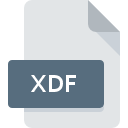.XDF File Extension

Microsoft Machine Learning Server Data File
| Developer | Microsoft |
| Popularity | |
| Category | Data Files |
| Format | .XDF |
| Cross Platform | Update Soon |
What is an XDF file?
The ‘.XDF’ file extension stands for “eXternal Data Frame,” representing a proprietary data storage format utilized within the ecosystem of Microsoft Machine Learning Server (formerly known as Microsoft R Server).
These files serve as containers for structured datasets, incorporating various features optimized for efficient data manipulation, analysis, and modeling.
More Information.
The primary objective behind the creation of the ‘.XDF’ file format was to address the challenges associated with handling large-scale datasets in the context of statistical analysis and predictive modeling.
Traditional data storage formats often struggled to cope with the volume and complexity of data encountered in enterprise-level analytics projects.
Thus, Microsoft R Server introduced the ‘.XDF’ format to provide a scalable and efficient solution for storing, processing, and analyzing vast amounts of data.
Origin Of This File.
The genesis of the ‘.XDF’ file extension can be traced back to the development of Microsoft R Server, a comprehensive platform designed to facilitate advanced analytics and machine learning tasks at scale.
Originally introduced as Revolution R Enterprise by Revolution Analytics, which Microsoft acquired in 2015, the platform underwent rebranding and integration into Microsoft’s ecosystem.
File Structure Technical Specification.
The ‘.XDF’ file format adopts a binary storage mechanism optimized for performance and scalability.
Its structure comprises a combination of metadata and serialized data representations, allowing for efficient storage and retrieval of dataset information. The technical specifications of the ‘.XDF’ format include:
- Header Information: Contains metadata describing the structure and properties of the dataset, including variable names, data types, and dimensions.
- Data Frames: Encapsulate the actual data content, organized in a tabular format with rows and columns.
- Compression: Supports various compression algorithms to reduce storage overhead and enhance data transfer efficiency.
- Chunking: Facilitates data partitioning into manageable chunks, enabling parallel processing and distributed computing.
- Serialization: Utilizes binary serialization techniques for efficient storage and retrieval of complex data structures.
How to Convert the File?
Converting ‘.XDF’ files to other formats may be necessary to facilitate interoperability with third-party tools and platforms.
While direct conversion methods may not be readily available due to the proprietary nature of the format, alternative approaches can be employed:
- Data Transformation: Utilize Microsoft Machine Learning Server or R programming language to read ‘.XDF’ files and transform them into common formats like CSV or JSON.
- Custom Scripts: Develop custom scripts or applications using programming languages such as Python or R to parse ‘.XDF’ files and extract data in desired formats.
- Third-Party Tools: Explore third-party software solutions or libraries that offer support for ‘.XDF’ file conversion, though availability may be limited.
Advantages And Disadvantages.
Advantages:
- Scalability: Designed to handle massive datasets exceeding the memory capacity of conventional systems.
- Performance: Optimized for efficient data processing, enabling rapid execution of analytical operations.
- Compatibility: Integrates seamlessly with Microsoft Machine Learning Server and other Microsoft ecosystem tools.
- Flexibility: Supports a wide range of data types and structures, accommodating diverse analytical use cases.
Disadvantages:
- Proprietary: Restricted to Microsoft’s ecosystem, limiting interoperability with non-Microsoft platforms and tools.
- Complexity: Requires familiarity with Microsoft Machine Learning Server and associated technologies for effective utilization.
- Resource Intensive: Processing and analyzing ‘.XDF’ files may require substantial computational resources, particularly for large datasets.
How to Open XDF?
Open In Windows
- Install Microsoft Machine Learning Server on a Windows system and use R or Python programming environments to access and manipulate ‘.XDF’ files.
Open In Linux
- Deploy Microsoft Machine Learning Server on a Linux server environment and leverage R or Python for interacting with ‘.XDF’ files.
Open In MAC
- While Microsoft Machine Learning Server does not have native support for macOS, users can explore virtualization or containerization solutions to run Windows or Linux environments for accessing ‘.XDF’ files.













